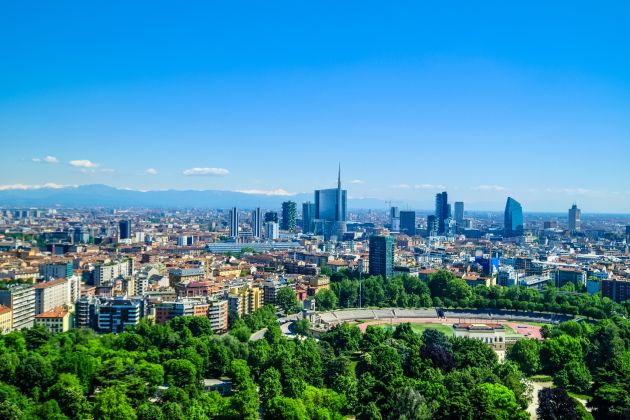 Milan, home of the world’s largest design fair and festival, sits in lockdown. Photo by Francesco Ungaro from Pexels.
Milan, home of the world’s largest design fair and festival, sits in lockdown. Photo by Francesco Ungaro from Pexels.
The coronavirus pandemic has already had a deep impact on design, but its true ramifications will only become apparent with time. Icon catches up with affected designers.
In the last two weeks, coronavirus has caused havoc globally. The public health crisis has precipitated an economic one, cutting chunks out of every industry. Design is far from exempt. The shuttered businesses, the cancellations and deferrals, the closed borders, the lack of demand for products beyond the essentials: these factors have inevitably had an immediate impact, and will continue to effect practitioners and studios for in months ahead. Many designers work as freelancers, a group hit especially hard by the sudden loss of work, without the same degree of financial support from governments as salaried employees.
The mounting recession caused by the crisis threatens the livelihoods of designers and sales by big brands. ‘It’s in bad taste to talk about selling,’ says Tom Lloyd of London-based product designers PearsonLloyd, ‘but somehow we need to keep on doing so. We’re not foragers.’ Buying high-end furniture is unlikely to be on the top of many minds now which is being felt by design brands. ‘We’re definitely seeing lower volumes,’ reports Petrus Palmér, founder and CEO of Stockholm-based design brand Hem, ‘with some markets grinding to a halt. I think it’s a little early to say what that will look like in the current weeks, but it’s alarming.’
As the supposedly solid foundations of the global economy continue to soften, some of the contractions we are facing might prove irreversible. Coronavirus throws up numerous questions for design’s future. ‘We’re suddenly having to reflect and reconsider how we operate at speed,’ says Lloyd, ‘and suddenly all our priorities are changing. Our personal health is the most important thing, but everyone’s also realises that without the economy running, the threat to our wellbeing is almost as great.’
Distribution is not glamorous, but it is central to design and it is impossible for it to run as usual at present. ‘We work with a web of suppliers throughout Europe,’ says Palmér, ‘and many of these are family businesses, generational businesses. Many of them are dependant on a few clients, and of course if volumes slow and we decrease our purchasing it will hit them very hard.’
 Design brand Hem opened its New York studio and showroom mere days before the city entered lockdown. Photo: Brian Ferry.
Design brand Hem opened its New York studio and showroom mere days before the city entered lockdown. Photo: Brian Ferry.
Chains run from producers to manufacturers, then to distributors and finally to consumers. The longer the chain, the more links there are to be damaged by a downturn. ‘I think we’re slightly better off than the average design brand,’ Palmér continues ‘because we have our own distribution, online and offline as well. And we’re also spread out — we have distribution all over Europe and in the US. Some markets are performing worse than others, but others are catching up.’
Design is a nebulous sector and as such the effect of Covid-19 will be manifold. It has certainly impacted the industry’s calendar, with many of the fairs and festivals were designers court international clients cancelled. Milan’s Salone del Mobile, the vastest fair of all, has been pushed back from mid-April to mid-June.NYCxDesign, Clerkenwell Design Week, PAD Paris, DesignMarch and Design Shanghai are among the events that have been postponed, and as the pandemic waves across the world the threat of cancellation looms. The future of group gatherings is uncertain for potentially the rest of 2020.
It is inevitable that the design industry will have to adapt in the short term but also beyond. National lockdowns such as those currently in place will inevitably have an impact on how companies approach international collaboration — if they continue, brands may need to find local partners to simplify production process. The design industry pivots around products that are essentially luxuries: in a post-pandemic economy, how much space will there be for the unessential? And if working from home persists, there might be a shift from the contract market to individual homes. ‘For a long period to come,’ predicts Pål Lunder, founder of the Norwegian mid-century modern specialists Fjordfiesta, ‘our home will be our safe haven and naturally we will spend more money on it. Then people will buy local well-made products to last.’
As the pandemic spreads internationally, there are seeds of hope for design. Design is a solution-orientated industry, used to adaptation. ‘We stand strong together,’ says Janne R Werdel of bespoke kitchen and wooden furniture company Hamran, ‘and out of a crisis there are always new opportunities. We can become more creative.’ And the severity of the catastrophe might bend designers’ minds towards preventing an even more acute one: the destruction of our world through climate change.
‘We have to reconsider our present society,’ says Benedicte Sunde of DOGA, Norway’s public architecture and design agency, ‘evaluate what impact our way of living has had on our planet and consider taking a u-turn and building up new models for trade in coexistence.’ When we come out of this, it will be a different world — and one in which design might truly play a role in changing things for the better.


















